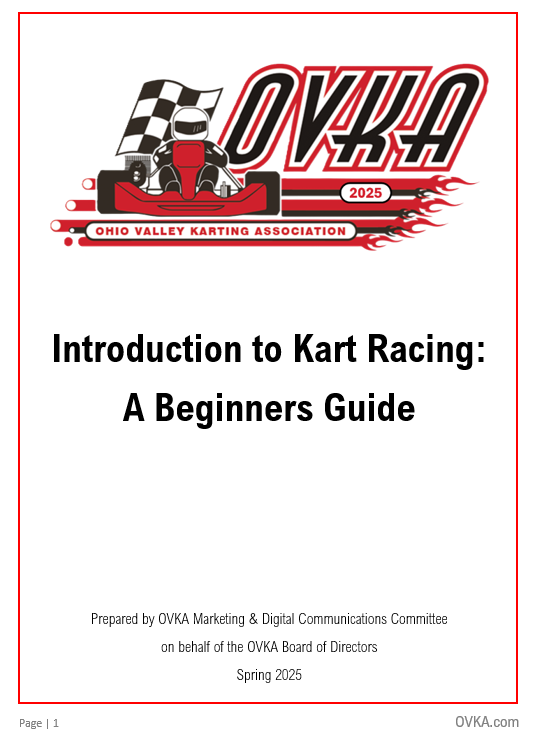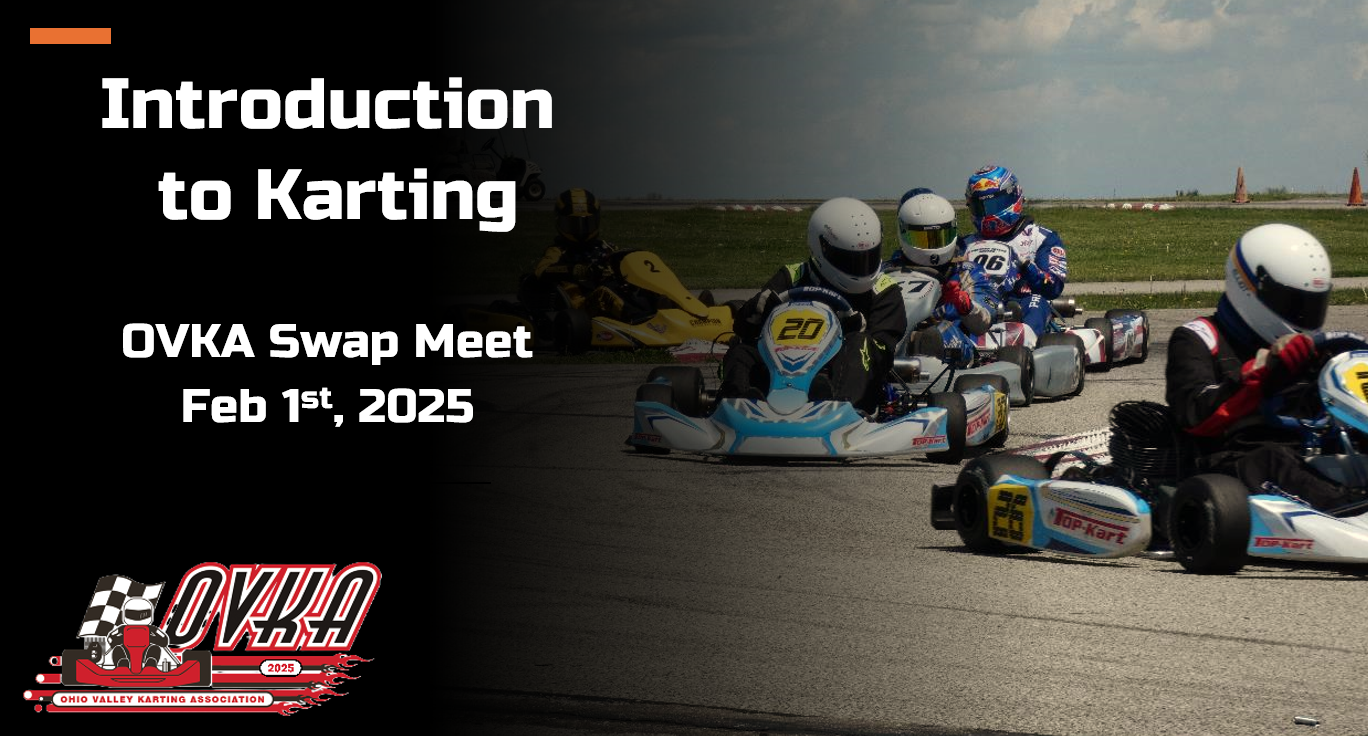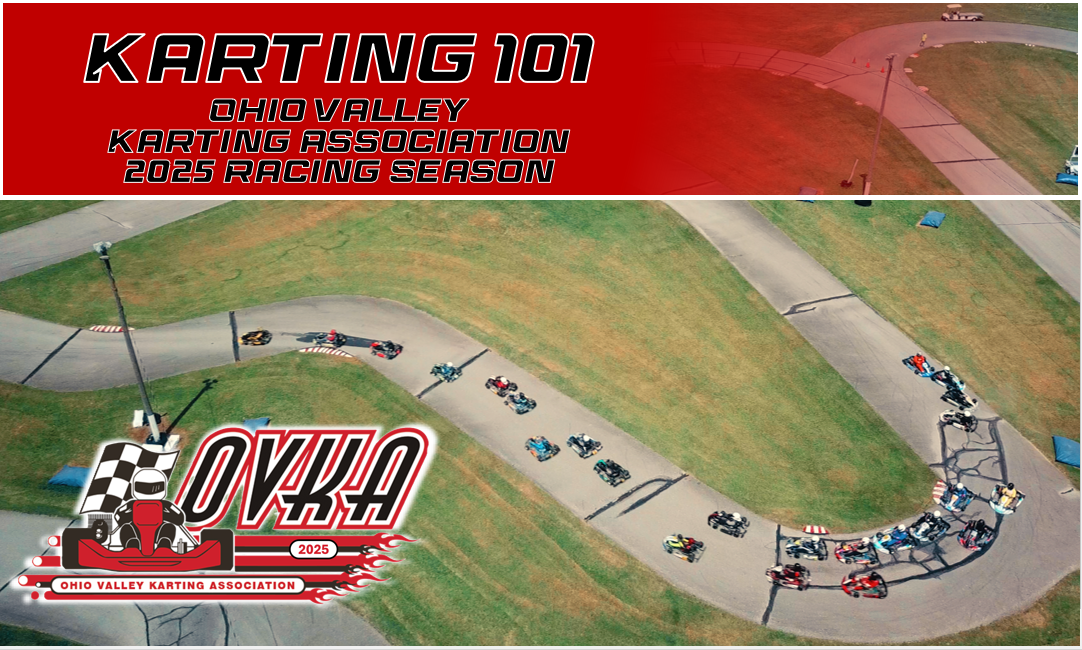HOW TO GET STARTED
Beginner's Guides to Kart Racing
FIRST STEPS
To get a taste of the racing world and determine if karting is right for you, we first recommend visiting one of our race days as a spectator. The OVKA schedule can be found on our website. G&J Kartway is open to public spectators during all OVKA events.
The OVKA holds races in the discipline of Sprint Karting, which is kart racing that takes place on a purpose-built road-course type circuit that is sized specifically for karts. Other types of karting exist for Road Racing (racing karts on race courses built for full-sized cars), for oval track racing on both dirt and pavement, as well as street circuit, and off-road racing.
As a spectator at an OVKA event, take the time to watch individual races at the track to get a sense for how the race day is run. Then take time to walk the pits and paddock area, taking note of the types of karts and how they are prepared. Feel free to ask questions of any available club members, who are always happy to help you learn more about how to take on the challenge of starting out in go-kart racing.
WHERE DO YOU FIT IN
Karting is a family sport with options for all ages to get racing on track. Children can begin as young as 5 years-old while some racers continue competing well into their 70’s. With interest and participation across such a broad spectrum, a standard set of age divisions has developed, which splits the participants into different classes.
CLASSES AND AGE GROUPS
In kart racing, the term “Classes” refers to the different divisions available for racers to participate in. Classes are defined both by age group and engine type, so that participants are always competing against rivals with similar equipment and within appropriate age groups. Each age bracket has multiple class options to choose from. On race days, each class will have its own dedicated set of warm-up times and races, where only members of their own class are on track at any time. Classes only compete against themselves and only score points within their own points championship. A full class summary for 2024 can be found on the RULES page.
Classes can vary in size depending on the popularity of their specific engine package, and as you first begin exploring your options in karting, you will want to find members of your prospective classes when you visit the track and ask them questions regarding their specifics:
- How much does the engine used in this class cost? (new vs used?)
- What kind of maintenance do you have to perform on it each week?
- How many participants on average show up for your class every week?
- How many participants do you expect in the future?
Each Class has a specific age limit, a set of acceptable engine rules and restrictions, and a minimum weight requirement for the combined kart & driver to ensure a fair playing field. Popular Class formats at OVKA are set by the World Karting Association (WKA) and the rules for each are consistent across most karting clubs and tracks around the country, with only small differences in weight requirements or accepted tire brands.
Certain classes may gain or lose popularity over time due to several factors, such as the shifting cost of parts and maintenance, or the consistency of engine performance. The large and varied engine manufacturer market means that there are many more class and engine options available in the karting world than OVKA can offer in a given season. You may see karts available for sale with engine packages that OVKA does not offer a points class for, so it is important to ask the right questions and purchase equipment for a class that will have a healthy participating group of competitors.
The OVKA offers the following popular classes across these standard age divisions:
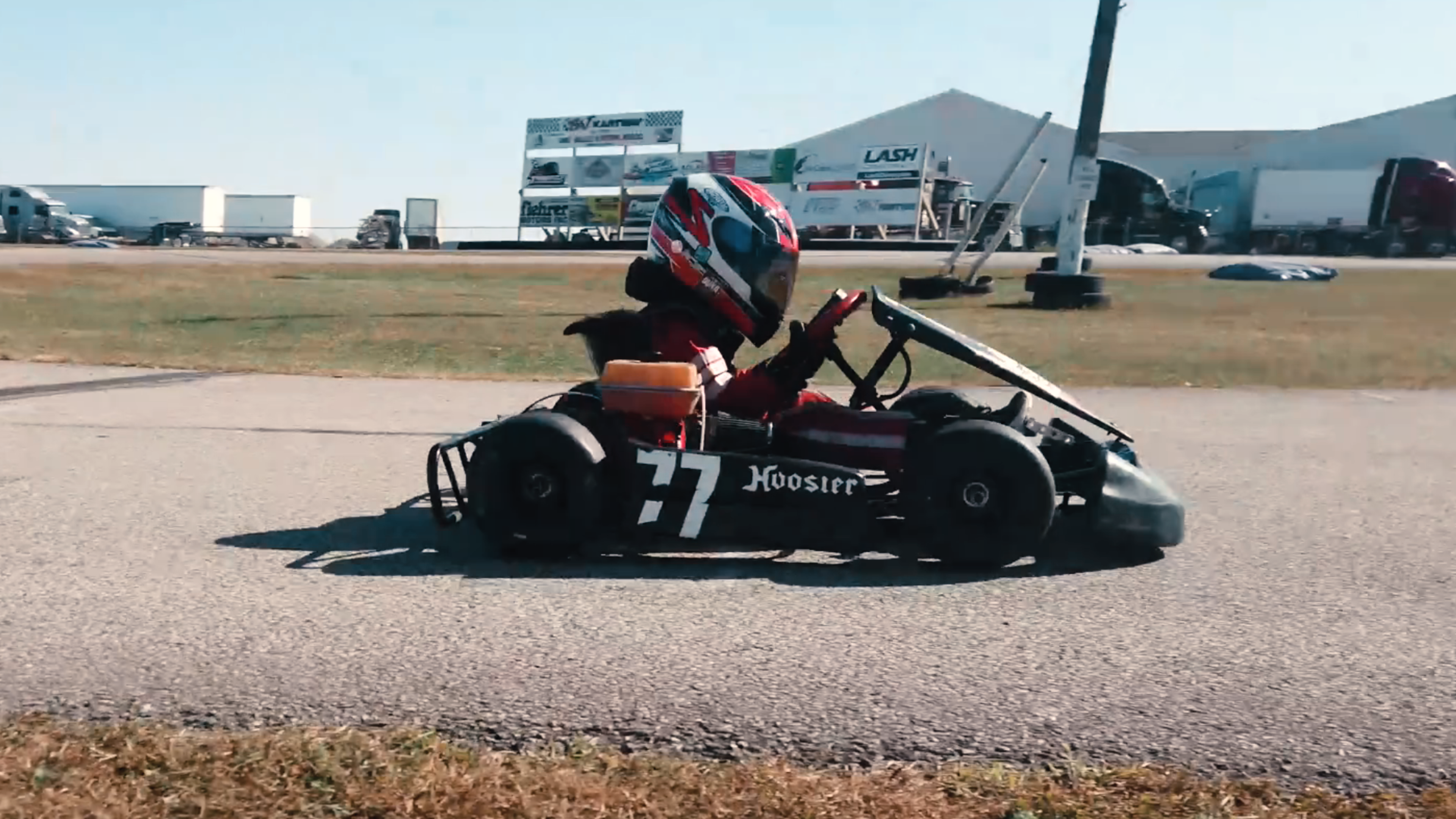
5-8 years old
KID KARTS - These karts generally use smaller chassis appropriately sized for children (~770-900 mm
wheelbase, commonly called KID KART chassis). The focus of Kid Kart racing is to develop the driving skills,
race craft, and driving awareness senses of these young participants. The most popular engine for several
decades has been the Comer C51 or C52 engine, a small (50cc) 2-cycle engine similar to what you’ll find on a
chainsaw or weed-whacker.
In recent years the 4-cycle Briggs & Stratton 206 engine, equipped with a specific Kid Kart restrictor, has
gained popularity in the United States as an alternative option. Briggs 206 Kid Karters may use CADET sized
chassis due to the physical size of the engine and the ability to move up to the Sportsman division without
needing to purchase a new chassis. The OVKA accepts both the Comer and 206 engines in our Kid Kart
divisions. Top speeds for Kid Karts can vary but are generally around 30-35 mph. Both of these class options
are considered low maintenance and effective for bringing Kid Kart aged drivers up to speed, and there is
widespread availability of used karts and components in the secondhand market.
For 2025, OVKA is also opening up our Kid Kart division to additional Kid Kart formulas in a non-points
capacity: The first non-points kid kart option, the Honda GHX50, is a 4-cycle engine that has been used in
karting for a number of years, with some availability in the secondhand market. This engine formula uses the
KID KART chassis size. The IAME M1 Bambino which will also be accepted in non-points kid karts, is a 60cc
2-cycle engine based on the IAME Swift. This engine, while more expensive, uses the Sportsman chassis size,
and allows conversion up into the Mini & Micro Swift classes without needing to buy a new engine.
OVKA Kid Kart Classes:
Comer Kid Karts
Comer C51 or C52 engine
150 lbs minimum weight (kart+driver)
206 Kid Karts
Briggs & Stratton 206 with 0.310” Kid Kart Restrictor Slide
200 lbs minimum weight (kart+driver)
Non-Points Kid Karts
(5-8 years old) [2 engine options]
Honda GXH50
150 lbs min. weight (kart+driver) or;
IAME 60cc M1 Bambino
180 lbs min. weight (kart+driver)
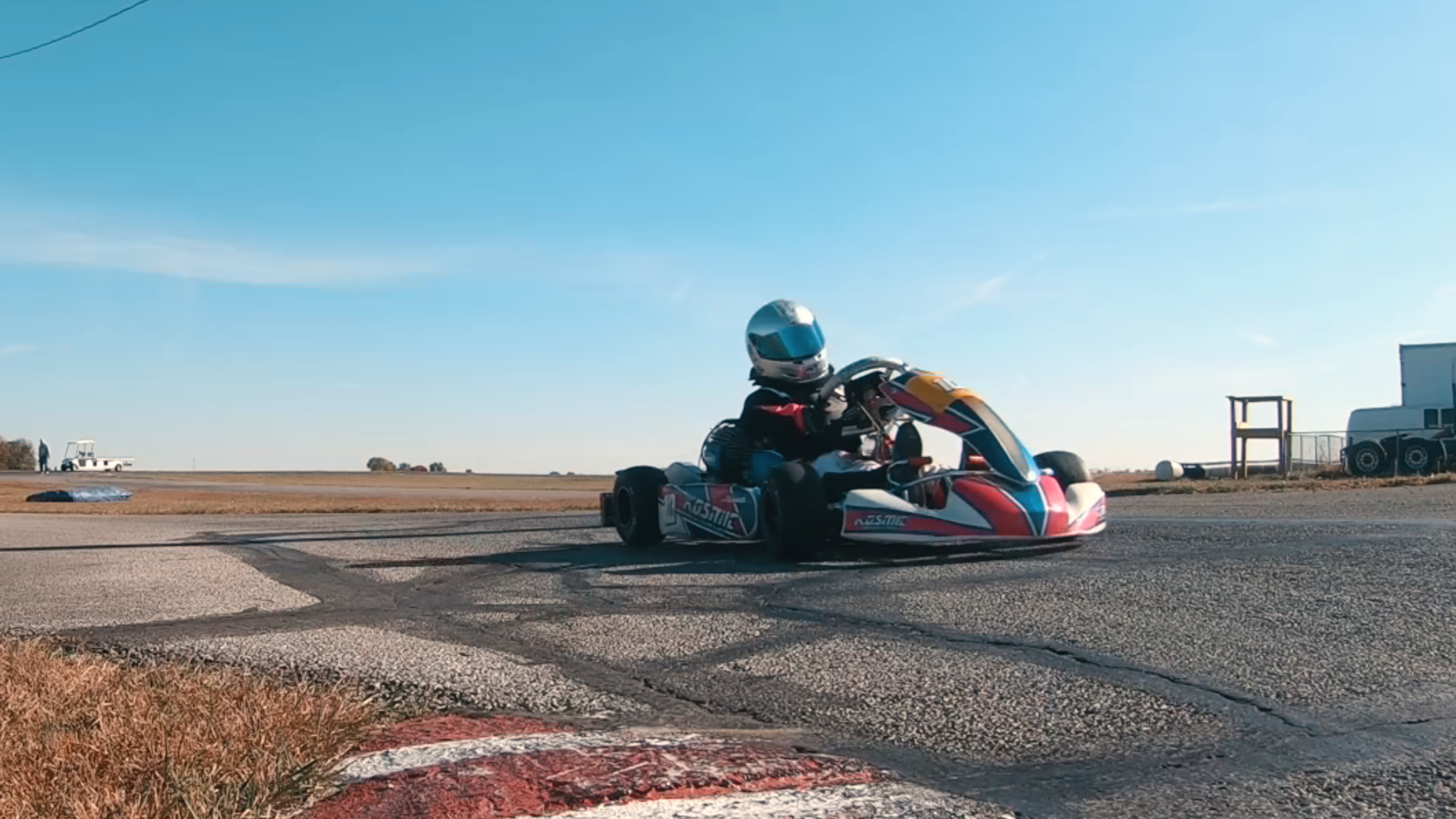
7-12 years old
SPORTSMAN / CADET –
This age division utilizes an intermediate sized kart chassis (~900-1010 mm wheelbase, commonly called CADET or SPORTMAN chassis), sized between a Kid Kart and full Adult sized frames. The classes available in the Sportsman age group at OVKA are the 4-stroke Briggs & Stratton LO206 Sportsman class and the IAME 60cc 2-stroke Mini Swift & Micro Swift classes.
Since its widespread adoption in the 2010’s, the Briggs & Stratton LO206 (colloquially called the “Briggs 206” or just “206”) has become the most widely used 4-cycle engine in sprint karting due to its affordable entry price, good reliability, and ease of use. Broad restrictions on the ability of racers to modify the internal components of these engines have led to considerable engine parity in the 206 classes, meaning close racing where a good driver can make a big difference.
The same 206 engine, equipped with different swappable power restrictors, can be used in every available age division in kart racing. In the Sportsman class at OVKA, the 0.490” Green restrictor slide is used. This is generally considered to be the most preferable class for introducing new kids at this age to the karting world.
Alternatively, the IAME Mini Swift & Micro Swift classes provide higher-performance options in this age bracket. The IAME-built 60cc 2-stroke engine package starts at a higher price point than the Briggs 206, but with higher price comes greater speed and increased power. The two class options for this engine are Micro Swift (for 7-10 year-olds) and Mini Swift (for 8-12 year-olds). Micro Swift utilizes a 16mm exhaust restrictor to limit engine power, and can act as a useful confidence-building class for many young racers to ease into the significant jump in speed to Mini-Swift, which runs with the standard exhaust header for the engine.
OVKA Sportsman Classes:
Briggs 206 Sportsman
Briggs & Stratton 206 with 0.490” Green Restrictor Slide
260 lbs minimum weight (kart+driver)
IAME Micro Swift
IAME Swift 60cc w/ IAME 16mm Exhaust Restrictor
225 lbs minimum weight (kart+driver)
IAME Mini Swift
IAME Swift 60cc
245 lbs minimum weight (kart+driver)
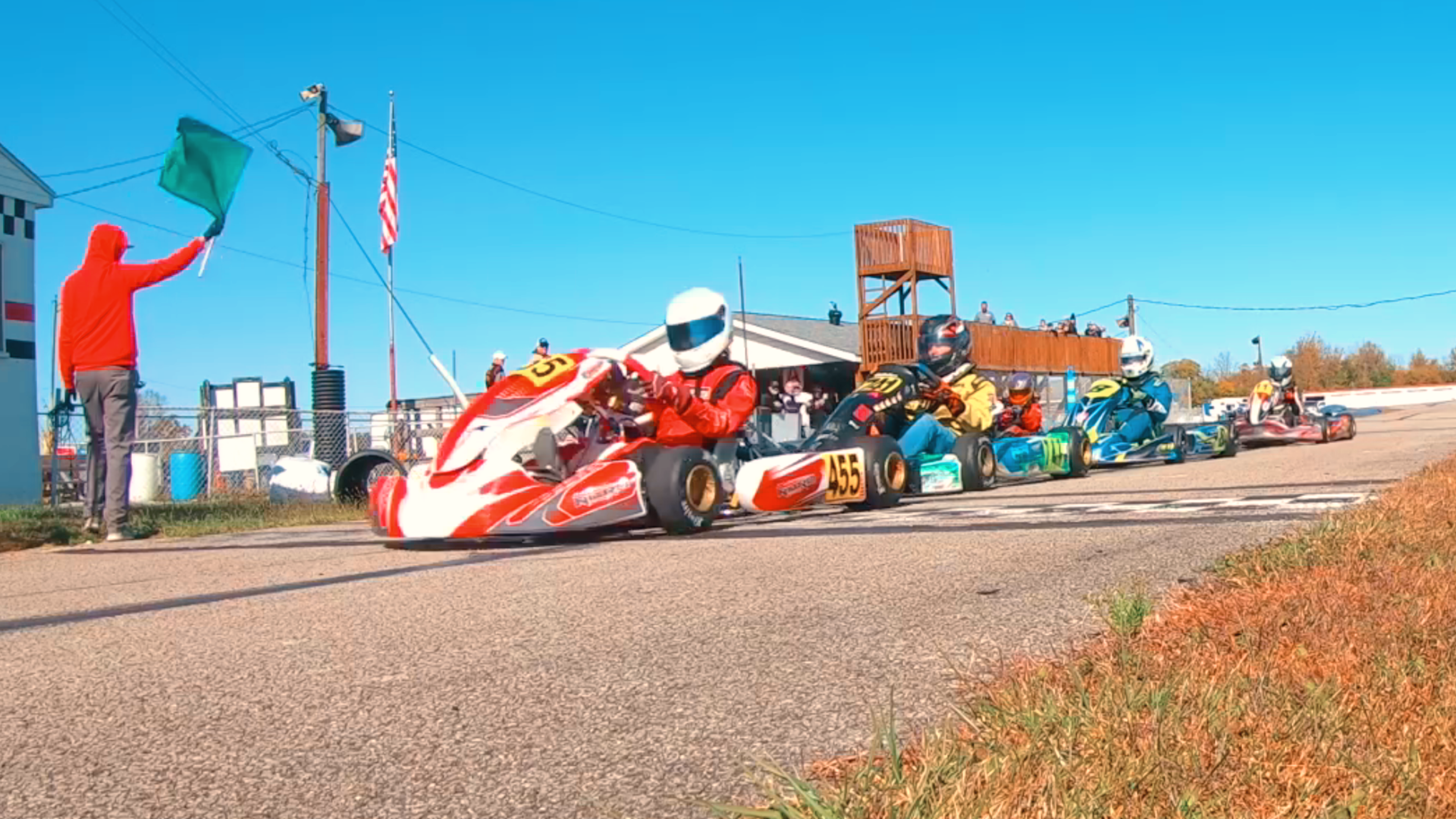
12-15 years old
Juniors -
The Junior classes offer increased speeds and are often some of the most well-attended and highly competitive classes at any karting club. At this age, full ADULT-sized chassis (~1045 mm wheelbase) are used in all classes. The two classes available in the Junior age group at OVKA are the 4-stroke Briggs & Stratton LO206 Jr class and the 100cc Jr class for 2-stroke engines.
As with its Sportsman iteration above, the Briggs & Stratton LO206 is used with a restrictor slide. For the 206 Junior class the 0.570” sized “Yellow” restrictor is mandated. Driving technique can be honed and perfected well in this class, where carrying corner speed and executing passes tactfully and cleanly is crucial with these tightly controlled motors. The popularity of the 206 engine has guaranteed well-attended grids for this class at OVKA and nearly every club where it has been offered.
On the 2-cycle side, the IAME KA100 is the primary engine used in the 100cc Junior class. Initially introduced in the United States for the 2017 season, the KA100 quickly supplanted the older 100cc 2-cycle engine classes due to its lower maintenance requirements and higher available power. Equipped with a 22mm exhaust restrictor for Juniors, speeds in this class can reach 55-60 mph. The KA100 has a higher operating cost to buy and maintain than the 206 option, but it comes with a marked performance increase for young drivers looking to build and test their skills at this age.
OVKA Junior Classes:
Briggs 206 Junior
Briggs & Stratton 206 with 0.570” Yellow Restrictor Slide
320 lbs minimum weight (kart+driver)
KA100 Junior
IAME KA100 with 22mm Jr Restrictor
320 lbs minimum weight (kart+driver) or;

15 years and older
Seniors –
Senior classes start at 15 years old and do not have an upper age limit. The chassis used are full-sized adult frames and engines at this level run at their least-restricted level, where speeds for the fastest karts push past 60 mph. The available Senior classes at OVKA are 206 Senior, 100cc Senior, OVKA 420, and the non-points Legacy Yamaha KT100.
The Briggs 206 Senior option is the most affordable way to have fun in a competitive adult karting league. The 206 package has proven itself as a reliable, cost-effective, and low maintenance formula that rewards great driving while providing a broad base for grassroots karting. In 206 Sr the engines run with the standard Adult (Black) slide. The continued runaway popularity of this class across the country will ensure healthy participation at every OVKA race and any other event you attend.
The 100cc Senior class offers the option to run a KA100 engine (without the restrictor used in Juniors), with 25+ hp available from the factory, or the comparable Vortex ROK VLR 2-cycle engine. The ROK VLR package offers a slightly more affordable buy-in price option to the KA100 and can be run competitively in the same class. Introduced in the US in 2018 by long-time kart engine manufacturer Vortex, it has seen success as an alternative to the KA100 at nationals-level events.
In addition, the OVKA 420 class is also available in this age bracket. This class is a Local Option class designed by OVKA and whose regulations are approved by the WKA. This class uses the 420cc Predator 4-cycle engine widely available at hardware stores and allows some modifications for racing (detailed in our rulebook) creating a higher horsepower, high-speed 4-cycle class designed to suit larger-build drivers.
OVKA also offers a non-points class for the legacy Yamaha KA100 engine. Prior to the introduction of the KA100 in the US, the Yamaha KT100 was the de-facto 100cc 2-stroke engine across many series and classes. Thousands of these engines are still available for sale at discount prices on the secondhand market.
OVKA Senior Classes:
Briggs 206 Senior
Briggs & Stratton 206 with Adult slide (Black)
365 lbs minimum weight (kart+driver)
100cc Senior
IAME KA100
360 lbs minimum weight (kart+driver) or;
Vortex ROK VLR
360 lbs minimum weight (kart+driver)
OVKA 420
420cc Predator OHV - modified
450 lbs (Rear Brake ONLY) or 460 lbs (Front + Rear Brakes) minimum weight (kart+driver)
Legacy Yamaha
Yamaha KT100
with SR-Y, RLV, CK4 pipe, or SSX can
360 lbs minimum weight (kart+driver)
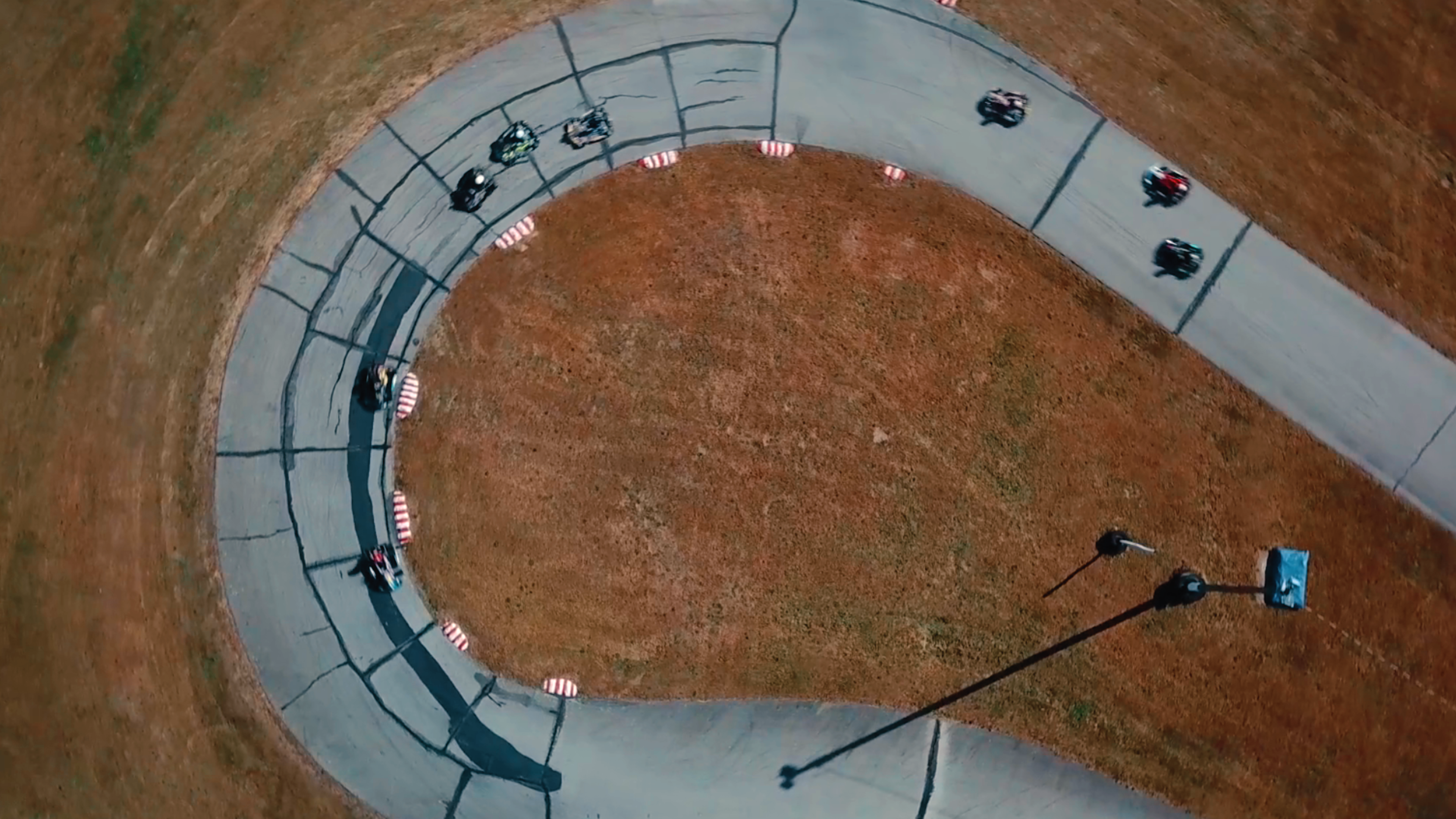
30 years and older, or 200lb+ Drivers (w/ permission)
Masters/Heavy – Masters classes offer our competitors the same engine performance as seniors, but in a division separate from their younger peers. While on-track competition is still fierce, masters classes can provide an overall more laid-back atmosphere for their participants away from the “intensity” of the teenaged drivers in the Senior field.
Masters also implements increased minimum weight requirements for both classes, which is attractive for drivers of larger build. Senior-aged drivers under 30 years-old who weigh over 200 lbs can also be approved into the masters classes early by the OVKA race director, rather than run at a performance disadvantage in Seniors, where excess weight can be a significant hinderance to performance.
As with all age groups, Briggs 206 continues to be popular in this age bracket, and in 100cc Masters, both KA100 and ROK VLR are again accepted, alongside the grandfathered-in Yamaha KT100.
OVKA Masters Classes:
Briggs 206 Masters
Briggs & Stratton 206 with Adult slide (Black)
390 lbs minimum weight (kart+driver)
100cc Masters
IAME KA100
390 lbs minimum weight (kart+driver) or;
ROK VLR
390 lbs minimum weight (kart+driver) or;
Yamaha KT100 with Formula Y Pipe
365 lbs minimum weight (kart+driver)
50 years and older
Legends – As karting in America continues to grow and proser, many older drivers who grew up racing are rekindling their love of karting or discovering it for the first time. Legends division classes are a growing trend in many karting series to give 50+ year-old members a dedicated place to compete with their peers. For 2024, OVKA is offering a Briggs 206 class for the Legends age group.
Briggs 206 Legends
Briggs & Stratton 206 with Adult slide (Black)
390 lbs minimum weight (kart+driver)
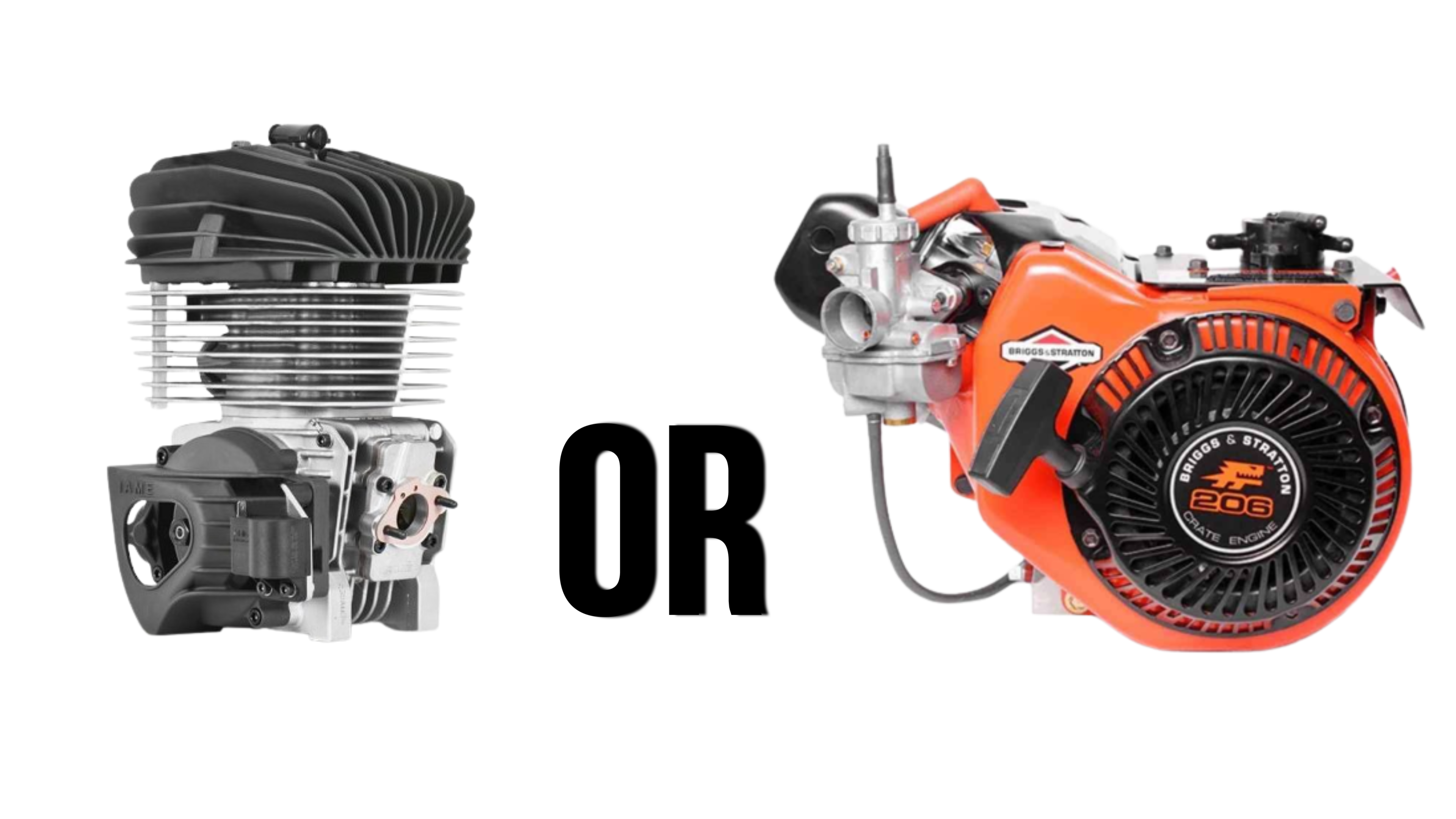
2-CYCLE vs 4-CYCLE ENGINES
Two-cycle and 4-cycle (“2-stroke” & “4-stroke”) refer to two different mechanical styles of engines. While 2-cycle engines have fewer moving parts and a higher power-to-weight ratio, they also spin or “rev” much higher than 4-stroke engines, and generally require more mechanical refreshing in the kart racing world.
Developing an understanding of the levels of maintenance in each class will help make your decision on where to race. The 4-cycle engines (like the popular Briggs & Stratton 206) will generally require an oil change (roughly 14 oz) every race weekend to remain competitive and keep the engine running well. Cleaning the air filter and carburetor every few hours of running is also good practice for maintaining the engine. However, this engine is capable of running a full season before a “refresh” of the top end and will go several seasons before needing a major rebuild.
The 2-cycle engines (like the Comer Kid Kart, IAME Mini/Micro Swift, KA100 and VLR) require you to mix oil in with your fuel before filling up to keep your engine lubricated, since 2-cycle engines do not have a traditional oil sump. You will also see gains in power from getting your engine “blueprinted” or rebuilt by a karting engine builder, and common rebuild intervals on the 2-cycle engines are much more frequent (potentially twice in a full season) for the top runners in club level racing. The 2-cycle engines will also need their air filters cleaned regularly, and the carburetors rebuilt every few races to continue running properly. Higher horsepower classes will also wear through tires, chains, and brakes more quickly than lower horsepower classes.
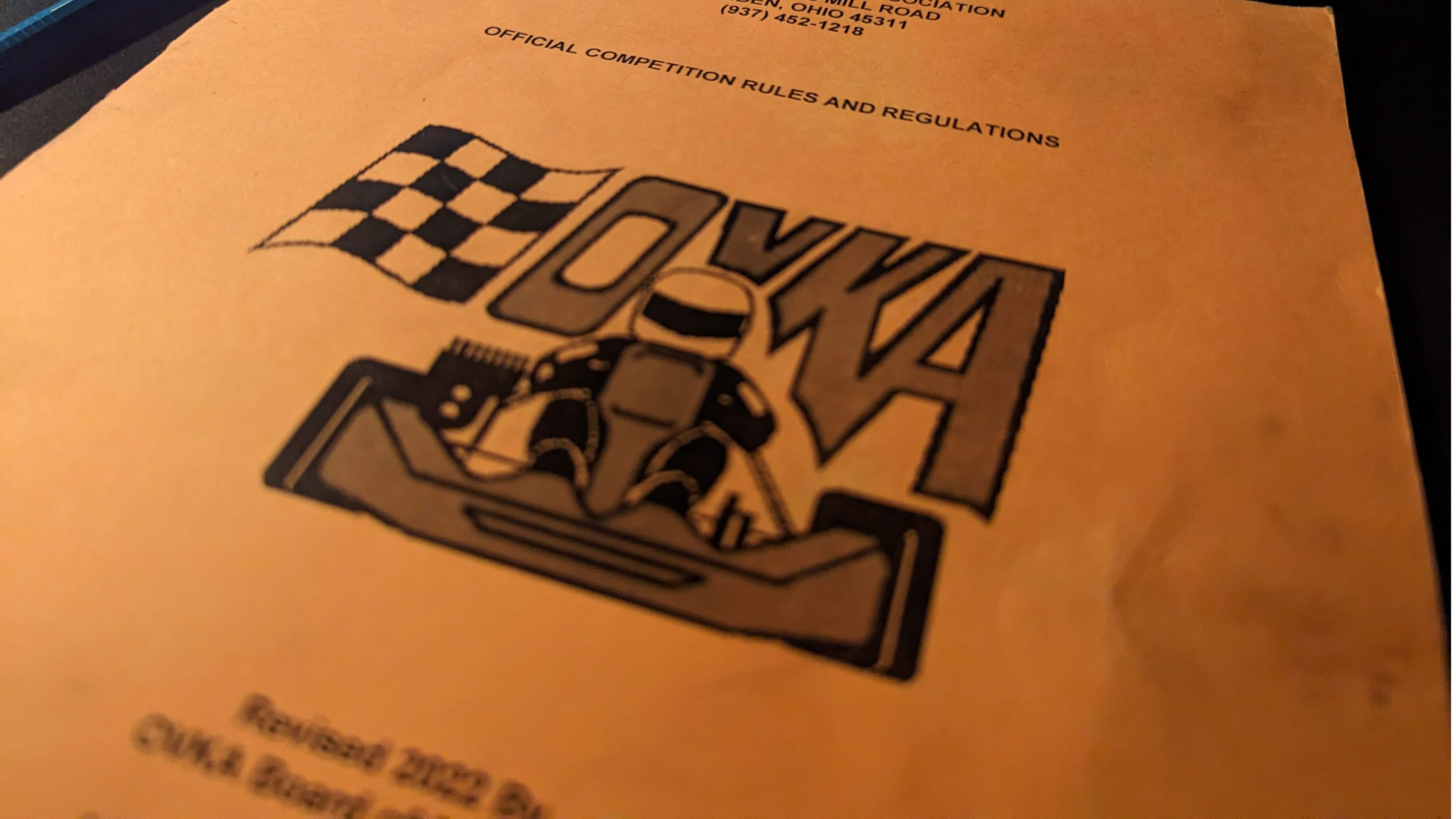
READ THE RULES
Download the OVKA rulebook on our website (OVKA.com) and familiarize yourself with what is allowed, and not allowed, when racing with the club. Before purchasing your kart, you’ll want to make sure that the chassis, bodywork, tires, and engine all meet the requirements laid out in this season’s rules document. You will also want to go through the Pre-Tech Safety Checklist to make sure that all proper safety items are either installed on your kart, or are able to be installed, before going to the track. On race day you may suffer disqualification for an overlooked noncompliant component if you are not familiar with the technical regulations.
You will also want to familiarize yourself with the race day procedures, on-track etiquette, and driver conduct expectations that are described in the rules. Unsportsmanlike conduct while driving or in the pit area will NOT be tolerated and can result in removal from the track or expulsion from the club.
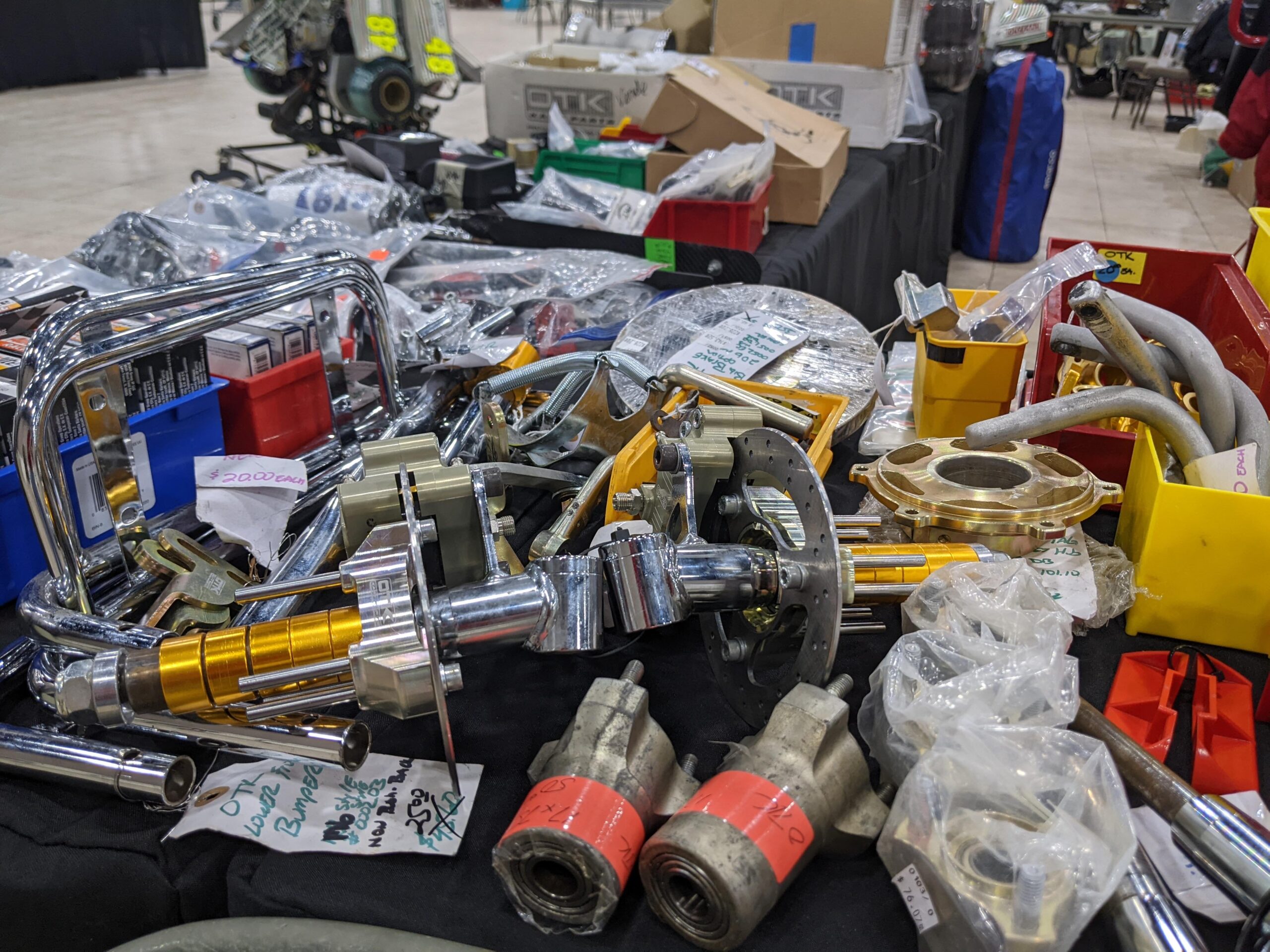
UNDERSTAND YOUR BUDGET
As with any sport or hobby, karting can get expensive very quickly. To find success and avoid any surprises, its useful to take stock of both the one-time costs and running costs for karting before jumping into a full season championship with an engine you’re unfamiliar with. The big one-time costs such as the kart and engine will be at the forefront of your mind, but don’t forget that fuel, oil, tires, and even brakes and chains are consumables that will have a long-term running cost, depending on how often you race.
Spare parts, tools, and support equipment for race day should also not be overlooked when planning your spending, as well as the required safety equipment such as your helmet and driving gear.
Used karts are often available within the karting community, and you may see some for sale when you visit the track. Online communities, such as Facebook Marketplace and other Karting Classifieds groups will have a large assortment of used equipment available at any time. Brick and mortar shops, like Comet Kart Sales in Greenfield, Indiana are also very useful for getting “hands on” the equipment you’re looking at, before you make a purchase. Online stores, such as Mondokart.com are also great resources for shopping around and comparing prices for parts and supplies. Some kart parts are sold through regular kart shops, while others may require purchase through an official dealer for the kart brand you’re buying for.
Some general pricing guidelines for what to expect for karts and engines are shown below:
|
"Ready-to-Race" Complete Karts |
||
|
|
New |
Used |
|
Kid Kart |
$2400-3000 |
$1000-1900 |
|
206 Sportsman |
$3700-4500 |
$1000-2500 |
|
Mini/Micro Swift |
$4500-6000 |
$2000-3000 |
|
206 Jr/Sr/Masters/OVKA 420 |
$3700-4500 |
$1000-3000 |
|
100cc Jr/Sr/Masters/Legend |
$5500-7500 |
$1500-5000 |
|
Standalone Engines |
||
|
|
New |
Used |
|
Comer C52 Kid Kart |
$1,050 |
$300-1000 |
|
Briggs & Stratton 206 |
$800 |
$400-600 |
|
IAME Mini/Micro Swift |
$1,995 |
$1000-1500 |
|
IAME KA100 |
$2,395 |
$1800-2000 |
|
Vortex ROK VLR |
$2,200 |
$1500-1800 |
|
OVKA Predator 420 |
$600 |
$1000 |
|
|
|
|
|
206 Engine Rebuild |
$200-300 |
|
|
Mini Swift Engine Rebuild |
$600-1000 |
|
|
KA100/VLR Engine Rebuild |
$700-1100 |
|
|
"Roller" Chassis (no engine) |
||
|
|
New |
Used |
|
Kid Kart |
$3,000 |
$400-1000 |
|
Cadet |
$3,500 |
$600-1500 |
|
Adult |
$3500-5500 |
$1000-3500 |

PURCHASING A KART
New racers in the world of karting should always consider purchasing used equipment to get started. New equipment may be nice, but it will always take time for a new racer to get to the point where they can make the “best use” of brand new equipment. Developing the “feel” for driving and learning the basics takes practice, and a driver without a frame of reference will need to build confidence and experience before they can tell the difference between and “old” kart and a brand-new chassis.
Since go-karts lack movable suspension, most of the movement the vehicle experiences while traversing bumps and negotiating corners comes from the chassis frame flexing beneath the driver. Over time, a chassis will get “flexed out” as the metal is over-worked and over time and will no longer handle in the corners as well as it was designed to. While a well-seasoned driver will be able to feel the difference between a new chassis and one that’s been used for many racing seasons, a new driver has much more to learn and experience before that potential performance deficit becomes a major hinderance.
However, brand new karts come with the benefit of being “untouched,” and carry the knowledge that they’re perfectly straight and have never been in an accident. You may have to spend extra time building and assembling a new chassis, and ensuring all safety checks are complete, but if you are jumping into karting from another form of racing a new chassis may be more attractive to you.
Pay attention to what brands of kart are popular at the tracks and clubs you’re going to be racing at. Chances are that other racers have gravitated toward those specific brands because they work well at the track, or because there are nearby networks of dealers and shops that carry parts for them.
Also pay attention to frame tube sizing when looking at karts. Frames for karts can come in 28mm, 30mm and 32mm tube sizes (and blends of them), with smaller tubes working better for lower weight and horsepower classes and larger tubes for higher horsepower karts. Some manufacturers make chassis intended for 206 or 4-cycle engines specifically, due to their lower horsepower. These may not perform well when used with higher-horsepower 100cc 2-cycle engines.
Notes:
You may see kart chassis for sale that are equipped with front brakes (Shifter Kart Chassis). All OVKA classes are rear-brake ONLY, except for OVKA 420 which allows an exception with higher weight.
You may see kart chassis for sale that are LTO (Left Turn Only). These are made specifically for oval racing and will not handle properly on a sprint karting road circuit like G&J Kartway.
THE CHASSIS BRANDS
Karting brands and manufacturers can be a bit confusing to remember. Many popular Sprint Karting chassis manufacturers are based in Europe and many manufacturers have a number of “sub-brands” that all come from the same factory and share the same parts. In the same way that General Motors may produce and sell cars under the Chevrolet, Buick, and GMC brand names, which share a pool of common parts under the hood, the OTK Group produces TonyKart, EOS, Kosmic, and Redspeed karts, which are functionally identical except for the color of the paint, and which also share interchangeable parts.
Chassis brands may have different reputations for working better in different environments or weather conditions, or for how easy they are to set-up well, or for the relative costs of their replacement parts. Talk to members of the karting community and get their input on your potential options.
A list of the current major manufacturers is listed here for your reference when looking at used models:
OTK Kart Group (Italy) - TonyKart, EOS, Kosmic Kart, Redspeed, Gillard, Exprit.
BirelART (Italy) - Birel, Ricciardo, Charles Leclerc, Kubica, CompKart, Swiss Hutless, Free Line, Comp Kart
Tinini Group (Italy) - CRG, GP, DR Kart, LH Kart, Evokart, Kali Kart, Maranello, Italcourse
IPK (Italy) - Praga, Formula K, OK1, RS Kart, ItalKart
SodiKart (France) - Sodi, Alpha, Tekneex
Parolin (Italy) - Parolin, Merlin, Vemme, Energy, TopKart, EuroStar, Oberon
Breda (Italy) - Kart Republic, Fernando Alonso Kart, Will Power
Emme Racing SAS (Italy) - Mad Croc, Race Factory, Drago, Magik Kart , AK USA
TBKart (USA)- TBKart, GFC, Trackmagic, Jacques Villeneuve
Drew Price Engineering (Australia)- Arrow, Sera, Monaco
Margay (USA)
Haase (Italy)
Comet (USA) Eagle
Factory Kart (USA)
Coyote (USA)
MGM (USA)
GFC (USA)
Magik (USA)
iKart (USA)
INSPECTING A USED KART
Always inspect a kart in person before buying. While photos are useful to gather information, getting hands on the kart to check the details is always worth the extra effort. When inspecting a kart for purchase, a few things to pay attention to are:
How old is the chassis? If the model is only a couple of years old, spare parts will be easy to find. If the chassis is a decade or more old, spare components may be hard to come by, even from the manufacturer.
Is the chassis straight? Or has it been in a bad accident and been bent beyond repair? Small tweaks are fixable, large deformations of the main chassis are not.
Always check the bottom of the frame rails. Excessive curb-hopping will grind the bottom of the rails, altering the chassis performance. While some scraping is inevitable, if the tubes feel like a “D” when you put your fingers on them, the chassis may be overly worn.
Check the welds. Cracks in the frame welds will dramatically alter the kart’s performance. While these can sometimes be fixed, unaddressed cracks should not be raced on.
Does the kart look well maintained? Cleanliness and attention to detail generally mean that the previous owner took good care of the kart. A kart with excessive oil, dirt, or tape on it may be hiding cracks and scrapes that would otherwise stand out.
Does the owner have extra spare parts to sell you, or are spare parts readily available? Some less popular brands, especially ones produced overseas, can be difficult and overly pricey to maintain if the manufacturer doesn’t have a US dealer network.
If it comes with an engine, does it start? Does it idle well? How many hours on it since a rebuild, and who was it by? Is it still legal to run in competition?
Does it have new tires? What brand and how old? Are they useable for practice or racing at the club you want to run? Practicing on older tires to familiarize yourself with the kart and track is fine, but you’ll want to race on newer tires to be competitive.
Does it come with a working Data Logger? (Commonly called a “tach”, short for tachometer, or by their brand names “MyChron” or “Alfano”) A data logger is indispensable in modern kart racing for keeping track of your lap times, engine RPM, and exhaust/head temperatures that are used to tune the kart’s performance.
Does the owner have setup sheets or data that they’re willing to give you? Can they help put a good starting setup on it for you? Are they willing to come to the track and help you get started? A good baseline setup can help you build confidence on track quickly.

TOOLS & SUPPLIES
Once you’ve purchased a kart, you should familiarize yourself with the common operations for working on it. Carefully re-read the Safety Pre-Tech Sheet and confirm your kart’s compliance with each item. Practice removing and installing the engine, changing gear/sprocket ratios, and adjusting the alignment to familiarize yourself with the mechanics, and also figure out where your home toolset may be lacking in specific tools. Go over every nut and bolt on the kart to confirm that everything is properly secured and learn the bolt sizes for every item. Some extra equipment you’ll need for operating smoothly at the track may also include things like:
Tools –
metric hex wrenches
metric sockets & wrenches
spark plug socket
torque wrench
a soft blow hammer
basic screwdriver set
snips, side cutters, and pliers
drill or small electric impact
Air Pressure- small air compressor or 5 gallon air tank as well as karting tire pressure gauge
A Range of gears/sprockets - Ask for help from club members on getting sprockets in the range used at the track (recommendations listed on Page 16), make sure to purchase sprockets and chains that match (#35 chain vs 219 chain).
Fuel jug and funnel – a fuel-rated jug, plus a measuring device if you’ll need to mix 2-stroke oils
Kart stand with wheels – Electric automatic stands are available as well as standard fixed ones to put your kart on between sessions to work on it
Pop-up canopy for shade (or to keep dry) – as well as proper equipment to tie it down or anchor it to the ground while you’re away from the pit
Fire extinguisher and first aid kit – Each club member is required by the rules to keep a small fire extinguisher in their pit or trailer for emergencies
Spare Parts – commonly used spare parts are tie-rods, steering column, axles, and chains
Spare Wheels and Tires - one set with practice tires mounted, and the other set with race tires mounted.
Notebook/Binder – Take time to print out the club rules, kart manufacturer setup guides and datasheets on components, keep detailed notes on how you change the kart setup as you practice and how it feels to you.
SAFETY EQUIPMENT
Some of the most important equipment you will purchase for karting will be the required safety devices. Some of these items have different requirements for children and adults. Aways purchase name brand equipment from reputable sources and check the tags for the required ratings.
Helmet – Helmets must have current SNELL or SFI ratings (see OVKA Rulebook). Tinted visors are legal for daytime races but clear or amber visors are required for OVKA night races. New karters must place an “X” in tape on the back of their helmets for their first three race weekends to let other drivers know they are new.
Race Suit - Drivers are required to wear either a full-length racing suit or a jacket constructed from an abrasion-resistant material. If wearing a jacket, full-length pants must be worn. Karting racing suits are typically more affordable than those for full-sized cars, as they do not have multi-layer flame-retardant Nomex linings.
Rib & Chest Protector – A chest protector and a rib vest are mandatory for drivers in the Kid Kart, Sportsman and Junior classes. The spec requirement is an SFI 20.1 rating which can be found on a tag on the unit. For Seniors and Masters classes, a rib protector is highly recommended.
Gloves - Either kart racing gloves, or motorcycle road racing gloves.
Neck protection - a "neck roll" or "neck collar" is required for all OVKA racers to limit head movement of the driver to prevent hyper-extension. There are several styles to choose from at most karting supply distributors.
Shoes - Closed-toed shoes must be worn. Driving shoes are highly recommended, as they provide a thin sole for the driver to feel their pedal-work more clearly.
SETTING UP YOUR KART
Take the time to set your new kart up for your own comfort, by adjusting the seat, steering wheel, and pedals to fit your stature so that you do not have to over-extend to reach the throttle or brake and can turn the wheel with natural motion. Go through every bolt and connection on your new kart and double check that they are secured and retained. You will not build confidence as a driver if you have a mechanical incident at your first day on track.
Starting with a good kart setup can go a long way toward helping build confidence in the driver. Your kart manufacturer may have “standard” settings for your kart that act as a good starting point for toe & camber, as well as axle height, stiffness, and torsion bar settings. You can also talk to members of the club for advice on chassis setup for newer drivers, as well as for advice on tire pressures and gear ratios.
G&J Kartway has a number of track configurations that can be used for competition, ranging from the tight and twisty A-configuration, to the fast and sweeping 1C-configuration. Finding the optimum gear ratio (between the clutch driver on the engine and the sprocket on the rear axle) for each track configuration is a key challenge in karting competition. Some broad guidelines for gearing are shown below. Note that new drivers will typically start on a larger ratio, and “remove teeth” from their rear sprocket as they build speed and familiarize themselves with the track. Also note that other clutch drivers are available as well, that can be used to fine-tune your ratios further.

FAMILIARIZE YOURSELF WITH YOUR KART
Practice starting your kart on a kart stand and bringing it to idle. (Never start a kart on the ground without someone in the seat to hold the brakes.) Make sure it idles cleanly, by adjusting the idle screw on the carburetor, and ensure the kill switch or mechanism shuts off the engine as its supposed to.
For younger drivers who may have no experience operating motorized vehicles, you might first find time to familiarize them with their new kart away from the track. Try setting up a small circle of cones in your driveway or in a large, open parking lot. (always follow posted traffic restrictions and NEVER operate a kart on public roads) to give them some seat time navigating around at a slow, walking pace. Many children can be startled by being so close to the engine noise of their new karts and giving them time to ease into the experience in a very controlled environment can work to quell their apprehension.
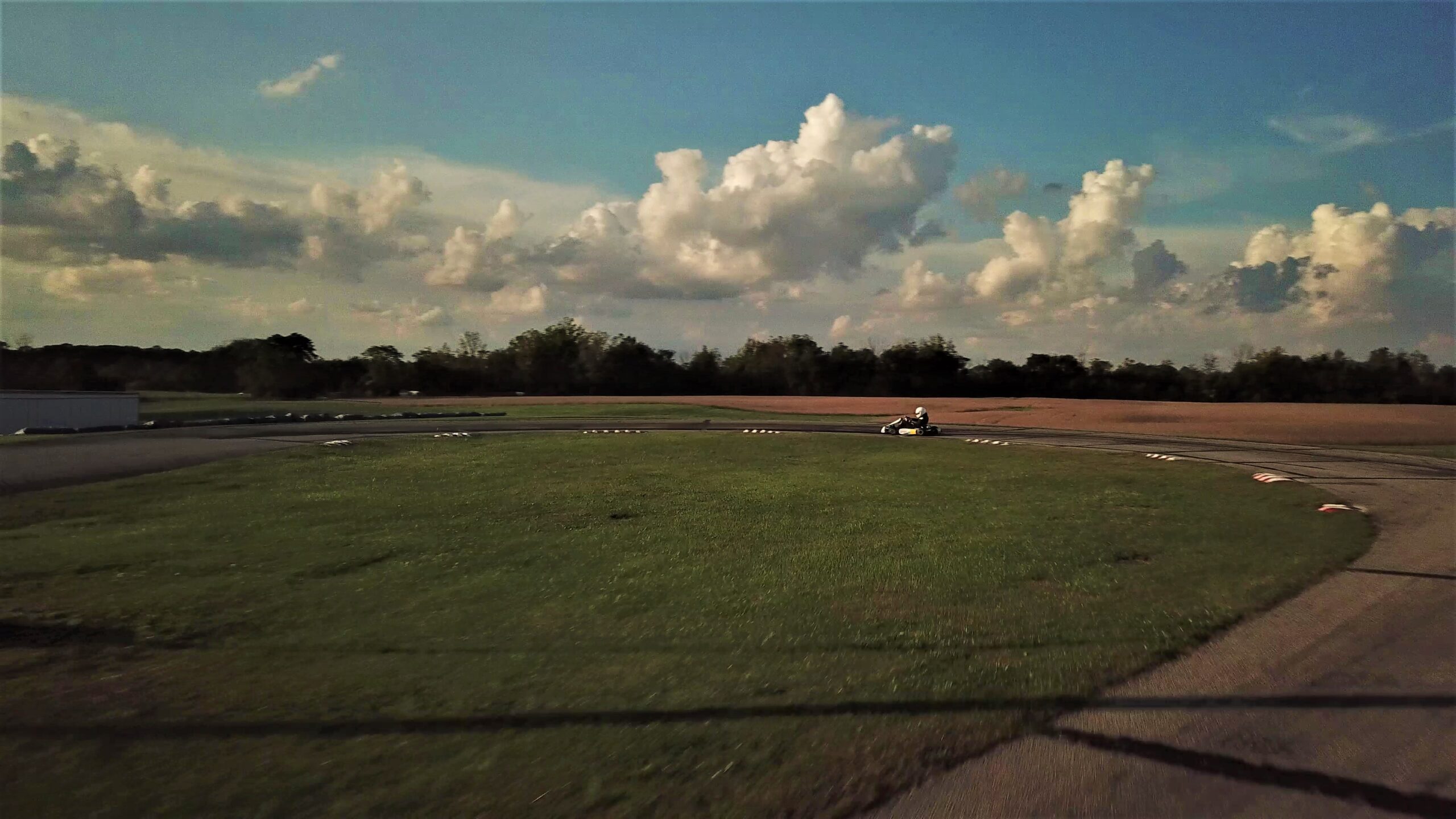
PRACTICE, PRACTICE, PRACTICE
Kart racing at this level is much different than you may have experienced at casual rental-kart tracks. Speeds are much higher and the circuit is much more open than you may realize. It is imperative that you familiarize yourself with your new vehicle and the track itself before simply jumping into a race event, for your safety and the safety of your new club-members and competitors. Begin watching onboard videos from G&J Kartway, and paying attention to the racing line. Many onboard videos can be found on YouTube, by searching “G&J Kartway” and/or the name of the class you’re interested in. Pay attention to kart placement on track, and braking and acceleration zones.
Find a time to visit the track when there is not a scheduled event (visit G&J Kartway.com for the full track schedule). If you can, plan to meet an existing member or group at the track for help and guidance.
Begin by walking the track configuration that you are about to drive, when no one else is driving on the track. Standard etiquette is to always practice the track configuration of the next upcoming race. A diagram of the available G&J Kartway configurations can be found here. Pay attention to where the racing line is (where the darkest areas of rubber are worked into the asphalt) and where black tire marks are built up on the curbs in the corners. These are the places you are going to want to position your kart when you start learning the fastest way around the circuit. Also pay attention to where its clear that other drivers have gone OFF the track, and left skid marks, scrapes, and dirt patches. These are the areas that are common for mistakes.
When you are ready, try taking your first laps with an empty of track, if possible, to give yourself plenty of room and space to make mistakes. Always raise your hand high above your head when entering and exiting the track to give proper notice to other drivers when you are going slowly, and never enter the track without stopping and looking for oncoming karts. If you spin or come to a stop on track for any reason, first raise your hands in the air to alert oncoming drivers, and only exit your kart when you are certain there are no oncoming vehicles.
Focus on building a smooth driving style, without harsh or abrupt inputs to the steering wheel or pedals. Pay attention to placing your kart on the racing line in the corners, where you observed on your track walk, and holding a consistent line on the straights, without weaving. Work in intervals of 5-10 laps at a time to avoid over-tiring yourself quickly. Do not forget to top off your fuel tank, oil your chain, and check your lug nut torques periodically as you run laps.
As you build speed, focus on doing longer runs, and extending the periods of time on-throttle before the corners. Your ultimate goal is to spend almost no time “coasting” into and through corners and instead either be on-throttle accelerating toward them, or then quickly braking for them, and returning back to the throttle as quickly as you can.
Try to build confidence and consistency such that you can run a full race length (8-10 laps) with every lap being within a 1 second window of each other with no major mistakes. Then try narrowing that window further. This will take many sessions, or days, at the track. But building consistency is key to running safely when other karts are on track with you.
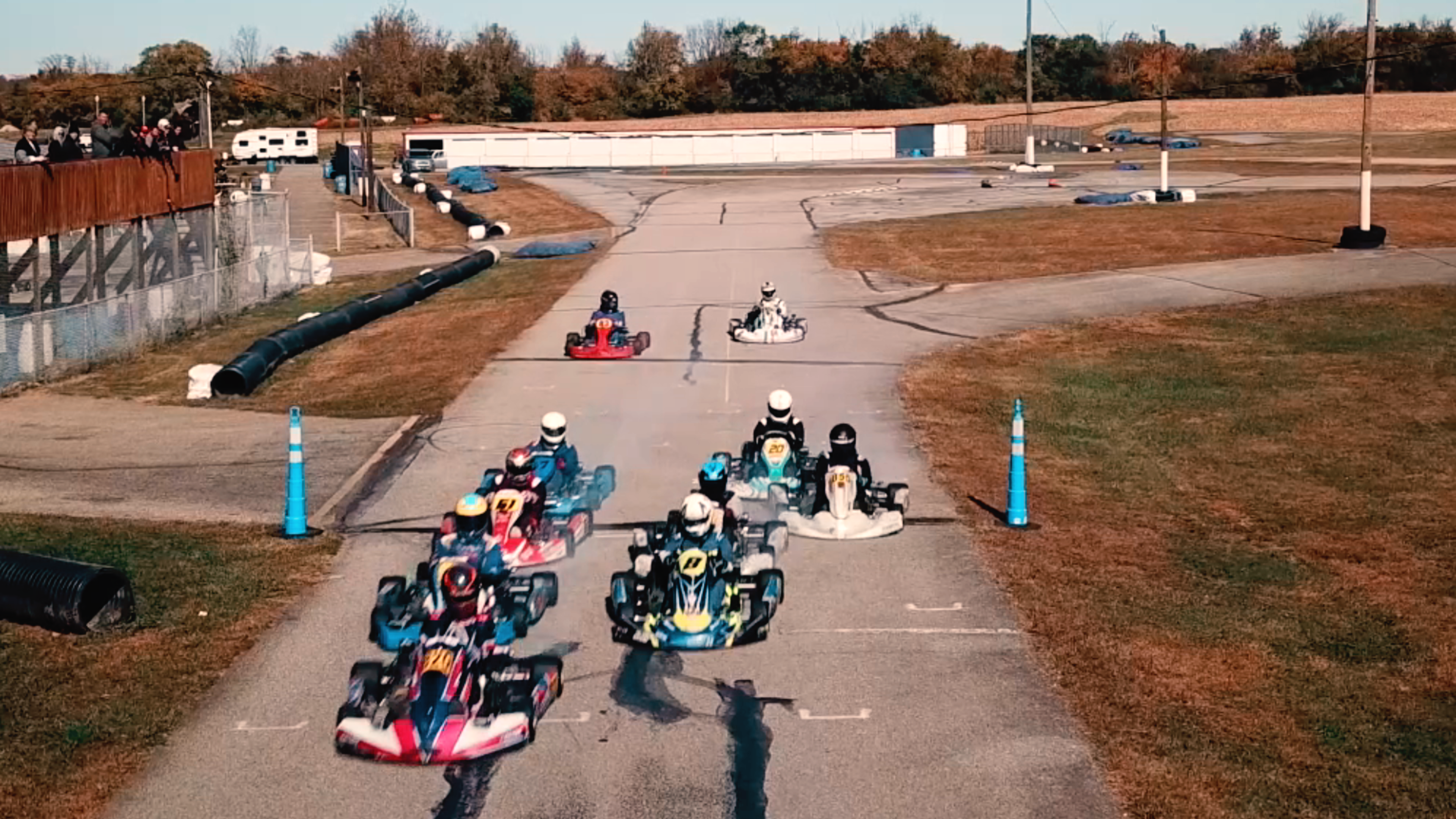
RACE DAY SCHEDULE
When you have turned enough practice laps to feel confident in yourself and your kart, its time to join in for a race day. Here is what to expect when you arrive, and how an OVKA event plays out:
7:00am – Gates Open: Gates to the track open, visit the entrance building on your way in to sign-in and purchase a Pit Pass Wristband. Find an open pit spot, either in the Free Pit Spots, or your own if you’ve reserved and paid for one. Begin unpacking and setting up your pit area.
7:30am – Registration & Pre-Tech Opens: Visit the Scoring Tower to Register for your class and rent a Timing & Scoring Transponder (if needed) and purchase fuel (if needed). You will be given Pre-Tech form to complete and return to complete registration. If this is your first race with OVKA, you will need a member of the Tech Team (Tech Director or Race Director) to inspect your kart and sign-off on your tech form that the appropriate safeties are in place. Pick-up your fuel and transponder and prepare your kart for Warm-Up.
9:00am – Class Warm-Ups: Each class will be given two 5-minute warm-up sessions. These go by very quickly, so be sure to have all of your equipment ready and be on the grid early for when your class is called. Give yourself room by starting at the rear of your field. Small classes of similar speed may be combined.
The order of warm-ups will be posted on the board at the head of the grid. Each class will go out for warmup in-turn and then the cycle will repeat for the second session. Be cautious on track during cool mornings and focus on turning solid laps with other karts around you. Try to follow other racers in your class and learn from their racing lines.
Take time to make notes after each session on your kart’s setup, how it felt on track, and any changes made. You must turn laps in at least one warm-up session to compete in the races.
11:00am – Drivers Meeting: A Mandatory drivers meeting will take place on the grid before racing starts. Here, the Race Director will go over the rules and procedures for the day and give any notes they may have for the Drivers. Minor drivers MUST have a parent present at the Drivers Meeting. Make sure to pay attention to the instructions given, especially the procedures for entering and exiting the track.
You will then be released to take your kart through painting, where each controlled component will be marked. Anything painted cannot be replaced for the remainder of the event without approval from the Tech Director. Painting may also occur at the conclusion of the first competitive session, as you cross the scales.
11:30am – Races Start: Competitive sessions will now begin. These can take a number of different forms at OVKA, which are explained in the following section.
Note: Times always subject to change due to weather or track condition. For OVKA Night Race events, all times are shifted forward accordingly from Gate Opening time.
OVKA RACE PROCEDURES
Each race begins by lining up on the grid in your given position. (New Karters will be required to start at the rear of the field for their first THREE race EVENTS). When the command is given, the class will pull off the grid and proceed to the track, where they will remain lined-up in-order for pace lap(s) on the “pace-oval” at G&J Kartway (see HERE). Classes will be given the Green Flag if the Head Flagger approves of the lineup and pace, otherwise they will be sent for additional pace laps.
The first racing lap when given the Green Flag at G&J Kartway uses the cut-through from Turn 1 to the back straightaway (See HERE) to allow adequate space for the field to fall into line. All other racing laps use the designated configuration for the day as shown. After taking the checkered flag, drivers will again use the pace oval at a slow, controlled speed to return to the scale lane for weigh-in
OVKA RACE FORMATS
Pea-Pick (Winner Take all) [Two Heat Races + Feature Race]: In this format, there will be three races for each class. The first race will have its starting grid set by a random draw, which will be posted on the board at the head of the grid before racing starts. Arrive at the grid with plenty of time to get ready before your race.
The second race will start with the starting grid for the first race inverted, (with new karters still at the tail-end). The average finishes for the first and second race will then be computed, and the Final race will be set with the best average finisher from the first two races starting first, and progressively down the field from there. The finishing order of the final will determine how points are paid out for the day.
Race lengths at G&J Kartway in this format are typically 8-10 lap Heat Races and a 10-12 lap Final.
Qualifying Format [5 min Qualifying Session + Pre-Final Race + Final]: In the qualifying format, the first session after the drivers meeting will be a 5-minute session very similar to warm-up, where all drivers will be allowed to freely run hot laps. The fastest single lap from each driver will be used to set the field for the Pre-Final race. The finishing order of the first race will then set the field for the Final. The finishing order of the final will determine how points are paid out for the day.
Race lengths at G&J Kartway in this format are typically 8-10 lap Heat Races and a 10-12 lap Final.
Qualifying + Extended Final [5 min Qualifying Session + Extended Final]: This format proceeds exactly like the qualifying format above, but with no heat race and a single, longer Feature Race.
Race length at G&J Kartway in this format is typically a 15-20 lap Final.
Champ Race Special Format [2-lap Qualifying Session + Pre-Final + Extended Final]: The OVKA Memorial Champ race is a special 2-day event held each summer. The race format for the Champ Race features standard warm-up sessions on Saturday, followed by a special qualifying session where each driver is given only 2 laps to set a fast time. On Sunday, drivers are offered an optional warm-up session, followed by a Heat race which sets the grid for the Feature. Top finishers in the Feature receive trophies/plaques at this race.
Race lengths at G&J Kartway in this format are typically a 8-10 lap Heat and a 15-20 lap Final.
OVKA CHAMPIONSHIPS
OVKA members earn points into their class championships following the format listed in the OVKA rulebook. Each driver is allowed a number of “drop” races, as described in the rulebook, meaning that club members do not necessarily have to make every event to be competitive for a championship, or can at least “drop” their worst points-paying days from their total. Top finishing Club Members in the season-long Championship receive awards at our celebration banquet each winter.
POST RACE MAINTENANCE
After a race day, always take the time to go through your kart to check for loose hardware and unseen damage. Clean and lubricate the needed components, and perform the routine maintenance recommended by your engine manufacturer. Keep a notebook of your laptimes, results, and how the kart responded to changes you made on race day. These records will be useful as you attend more races and improve your driving and race-craft and begin looking to find more and more competitive laptimes through optimal kart setup.
THANK YOU FOR READING
The OVKA Hopes to see you at the track in 2024 and beyond. Please reach out to our board members if you need any help or guidance on your journey into the world of kart racing.
NOTE: The information provided in this guidebook is intended only as a general reference for new kart racers. The OVKA Rulebook and the manufacturer technical documents referred to therein are the ONLY definitive sources for all club procedures & technical regulations. Those documents should be deferred to in any and all cases where specs, rules, procedures, or information may differ from those described in this document.

